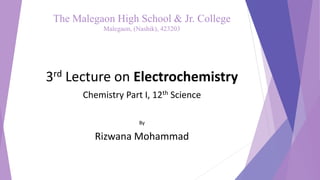
3rd Lecture on Electrochemistry | Chemistry Part I | 12th Std
- 1. The Malegaon High School & Jr. College Malegaon, (Nashik), 423203 3rd Lecture on Electrochemistry Chemistry Part I, 12th Science By Rizwana Mohammad
- 2. Electrochemical cells: An electrochemical cell consists of two metal plates or carbon (graphite) rods. These electronic conductors are dipped into an electrolytic or ionic conductor. • Electrochemical reactions are redox reactions. Electrodes: Electrodes are surfaces on which oxidation and reduction half reaction take place. Electrodes may or may not participate in the reactions. The electrodes which do not take part in reactions are inert electrodes. Cathode: It is an electrode at which the reduction takes place. Anode: It is an electrode at which oxidation takes place.
- 3. Types of electrochemical cells: There are two types of electrochemical cells. 1. Electrolytic cell: • In this type of cell a nonspontaneous reaction, known as electrolysis, is forced to occur by passing a direct current from an external source into the solution. • In such cells electrical energy is converted into chemical energy. 2. Galvanic or Voltaic cell: • In galvanic or Voltaic cell a spontaneous chemical reaction produces electricity. • In these cells chemical energy is converted into electrical energy. Electrolytic cell: • Electrolytic cell consists a container in which electrolyte is placed. Two electrode are immersed in the electrolyte and connected to a source of direct current. • The anode of electrolytic cell is positive and cathode is negative.
- 4. Electrolysis of molten NaCl: Construction of cell: • The electrolytic cell consists of a container in which fused NaCl is placed. • Two graphite electrodes are immersed in it. • They are connected by metallic wires to a source of direct current that is battery Reactions in the cell: Oxidation half reaction at anode: 2Cl(l) → Cl(g) + Cl(g) +2e (primary process) Cl(g) + Cl(g) → Cl2(g) (secondary process) 2Cl(l) → Cl2(g) + 2e overall oxidation Reduction half reaction at cathode: Na(l) + e → Na(l) + - - - - -
- 5. Net cell reaction: The net cell reaction is the sum of two electrode reactions. 2Cl(l) → Cl2(g) + 2e (oxidation half reaction) 2Na(l) + 2e → 2Na(l) (reduction half reaction) 2Na(l) + 2Cl(l) → Cl2(g) + 2Na(l) (overall cell reaction) Results of electrolysis of molten NaCl: i. A pale green Cl2 gas is released at anode. ii. A molten silvery-white sodium is formed at cathode. Decomposition of NaCl into metallic sodium and Cl2(g) is nonspontaneous. The electrical energy supplied by the battery forces the reaction to occur. Electrolysis of aqueous NaCl: The electrolytic cell consists of a container in which aqueous NaCl is placed. Two graphite electrodes are immersed in it. They are connected to battery. + - - - -+
- 6. Reduction half reaction at cathode: • At cathode, two reduction reactions compete. • One is the reduction of Na ions as in case of molten NaCl. i. Na(aq) + e → Na(s); E0 red = -2.71V The other is the reduction of water to hydrogen gas. ii. 2H2O(l) + 2e → H2(g) + 2OH(aq); E0 red = -0.83V • The standard potential for the reduction of water is higher than that for reduction of Na. • This implies that water has much greater tendency to get reduced than the Na ion. • Hence reaction (ii), i.e. reduction of water is the cathode reaction when the aqueous NaCl is electrolyzed. - + + - + - +
- 7. Oxidation half reaction at anode: • At anode there will be competition between oxidation of Cl ion to Cl2(g) as in case of molten NaCl and the oxidation of water to O2(g) i. 2Cl(aq) → Cl2(g) + 2e; E0 oxi = -1.36V ii. 2H2O(l) → O2(g) + 4H(aq) + 2e; E0 oxi = -0.4V • Standard electrode potential for the oxidation of water is greater than that of Cl ion. • It is therefore. Expected that anode half reaction would be oxidation of water. Overall cell reaction: It is the sum of electrode reactions 2Cl(aq) → Cl2(g) + 2e(oxidation at anode) 2H2O(l) + 2e → H2(g) + 2OH(aq) (reduction at cathode) 2Cl(aq) + 2H2O(l) → Cl2(g) + H2(g) + 2OH(aq) - - + - - - - - -- - -
- 8. Results of electrolysis of aqueous NaCl: i. H2 gas is liberated at cathode. ii. Cl2(g) is released at anode. iii. Because Na ions remain unreacted and OH ions are formed at cathode, NaCl solution is converted to NaOH solution. + -
